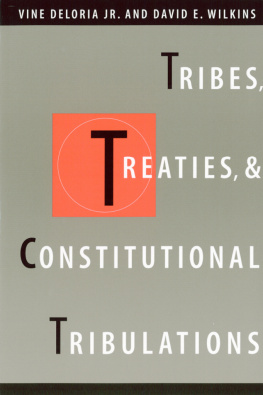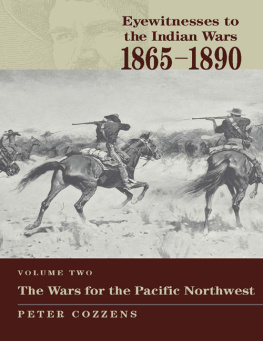


1977, 2012 Vine Deloria Jr.
First published by Doubleday & Company, Inc., 1977
All rights reserved. No part of this book may be reproduced or transmitted in any form or by any means, electronic or mechanical, including photocopying, recording, or by an information storage and retrieval systemexcept by a reviewer who may quote brief passages in a reviewwithout permission in writing from the publisher.
Library of Congress Cataloging-in-Publication Data on file
ISBN 978-1-55591-688-6 (pbk.)
ISBN 978-1-55591-765-4 (ebook)
Printed in the United States of America
0 9 8 7 6 5 4 3 2 1
Design by Jack Lenzo
Fulcrum Publishing
4690 Table Mountain Dr., Ste. 100
Golden, CO 80403
800-992-2908 303-277-1623
www.fulcrumbooks.com
Foreword
Vine Deloria Jr. and the Indians of the Northwest

Billy Frank Jr.
I dont even remember when I first met Vine. It might have been when he was with the National Congress of American Indians in 1969. Or it might have been when he came up to the Northwest to teach at Western Washington University in 1970. But it seems as if I had always known him. It seems like he was always there fighting for us. Vine was always on the front lines.
Vine was a big part of our fight to win our fishing rights. He protected us. Whenever we got in trouble exercising our sovereign rights, we would call him and he would help. He would give speeches, testify on our behalf, and once he appeared on The Dick Cavett Show telling our story. He helped us win the Boldt decision.
After the Boldt decision, the commercial fishermen tried to undersell the Indian fishermen. Also, the State of Washington passed a law that steelhead could not be sold in the state, so we had no market for our salmon and our steelhead. We called Vine, who was in New York at the time. Vine found us a good market for our fish with the Mafia at the Fulton Fish Market in New York City. We butchered our fish at Franks Landing at the mouth of the Nisqually River, boxed them, and took them right to Sea-Tac airport to send back East.
Another time we were in Portland, Oregon, hauling cigarettes to our smoke shop at Franks Landing. The Department of Revenue stopped us and confiscated our cigarettes and our truck. We had paid federal taxes on those cigarettes, but not state taxes. We called Vine. He sent us money and told us how to contact a judge and get an injunction. We did that, and we won. We got our cigarettes home, thanks to Vine. We used that money to support our fishing rights struggle. Vine was always on call to help us.
Vine used to hold traditional knowledge conferences. We had conferences on the animals, on the stars. I always attended those conferences. One year, he held his conference at Franks Landing. We held it at the powwow grounds, at the Wa He Lut School. He brought us together, and we talked about giants and little people. We never recorded it, but I remember it just like it was today. We opened with a prayer and a ceremony. There were about a hundred of us there, all in a circle holding hands. It was a powerful thing, a sacred thing. Thats what Vine didhe brought us together.
The last time I talked to Vine was at the final traditional knowledge conference held in Albuquerque, New Mexico, in 2005. Vine was sick then and couldnt come personally, so he telephoned us. We put him on the loudspeaker, and he talked to us. He passed away not long after that. Vine may be gone now, but in reality he is always with us. Wherever we go, Vine is still therestill watching over us every day. We continue to fight for our rights, and he continues to fight with us. One of the ways that Vine remains with us and helps in our fight is through his books and other writings.
Vine was our historian. I have always read Vines books and they have helped me set my own course. He wrote the truth. He tried to rectify all the lies that were told about Indians. We have twenty-nine tribes in the State of Washington, and nobody knows our true story. Our own children dont know our true story. This is why Indians of the Pacific Northwest is so important. After more than thirty years, it is still the best book about the history of our people and what we went through, how we survived. It is a book that everyone should read. But most importantly, it is a book that needs to be read by our own people, and especially our young people.
Chapter One

When I was first elected to the directorship of the National Congress of American Indians, I was introduced to the tribes of the Pacific Northwest, particularly those tribes that live in and around the Puget Sound area. The Makahs, who live on Cape Flattery, one of the northern peninsulas of Washington State, told me how a Spanish expedition in the late 1700s had invaded their lands and built a fort. The Makahs bided their time, cleverly captured the fort one morning, and sent the Spanish fleeing for their boats, leaving behind cannons, guns, and all manner of goods. While the name of Juan de Fuca was given to the strait between the lands of the Makahs and Vancouver Island, the lands and waters remained in the hands of the Indians for some time afterward.
The chief complaint of the Indians of the Pacific Northwest when they would come to the national Indian political conventions would be that the whites, particularly the officials of the fish and game departments of Washington State, were violating their treaties and harassing the Indian fishermen. I grew up in South Dakota, a member of the Sioux tribe, and when we talked about fish in that country we were talking about something approximately six inches long that you were sometimes lucky to get out of a creek in midsummer. So I could never figure out just what the problem was in Washington State, and the idea of people complaining because they couldnt go fishing seemed a little absurd to me at the time.
But the coastal tribes kept after the rest of us. They would compare the salmon with the buffalo, telling us how the salmon was to them what the buffalo had been to the Plains tribes. It was, we all agreed, ridiculous to compare a tiny fish with the magnificent animal that had provided us with food, clothing, weapons, and other articles of our culture. We were polite but firm and tried to press on to larger and more important topics of discussion that affected Indians all over the nation.
Finally, perhaps in some despair over the stupidity of this Plains Indian they were trying to educate, the Pacific Northwest tribes invited me to come to Washington State and attend a meeting on Indian problems. I was eager to get out and meet the people of the different tribes, and so I accepted and flew to Seattle. A car picked me up, and we went to the state capital, Olympia, where the Indians were having a banquet with their congressman, Lloyd Meeds, who has spent his time in Congress working hard with the tribes to resolve some of their problems.
There were nearly fifty Indians at the banquet, and, of course, salmon was served. Everyone ate his fill of the delicious meal, and after the ceremonies and speeches one of the Indians took me to the kitchen to see the remains of the salmon that had provided us with our meal. I was confronted with the skeletal remains of a gigantic fish, far surpassing in size the tiny catfish of my youth. When I learned that this one salmon had fed the entire banquet, I came to understand why the salmon was so important to these people.





![Deloria Jr. - Behind the trail of broken treaties an Indian declaration of independence. [The goundbreaking work by the preeminent spokesperson for American Indian rights]](/uploads/posts/book/171989/thumbs/deloria-jr-behind-the-trail-of-broken-treaties.jpg)





